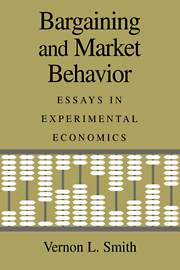Book contents
- Frontmatter
- Contents
- Preface
- Part I Economics and Psychology
- Part II Bargaining Theory, Behavior, and Evolutionary Psychology
- Part III Institutions and Markets
- INTRODUCTION
- 10 Reflections on Some Experimental Market Mechanisms for Classical Environments
- 11 Experimental Methods in the Political Economy of Exchange
- 12 Individual Rationality, Market Rationality, and Value Estimation
- 13 Market Contestability in the Presence of Sunk (Entry) Costs
- 14 The Boundaries of Competitive Price Theory: Convergence, Expectations, and Transaction Costs
- 15 Off-Floor Trading, Disintegration, and the Bid–Ask Spread in Experimental Market
- 16 Bertrand-Edgeworth Competition in Experimental Markets
- 17 An Experimental Examination of the Walrasian Tâtonnement Mechanism
- Part IV Stock Markets and Bubbles in the Laboratory
- References
- Index
INTRODUCTION
Published online by Cambridge University Press: 29 October 2009
- Frontmatter
- Contents
- Preface
- Part I Economics and Psychology
- Part II Bargaining Theory, Behavior, and Evolutionary Psychology
- Part III Institutions and Markets
- INTRODUCTION
- 10 Reflections on Some Experimental Market Mechanisms for Classical Environments
- 11 Experimental Methods in the Political Economy of Exchange
- 12 Individual Rationality, Market Rationality, and Value Estimation
- 13 Market Contestability in the Presence of Sunk (Entry) Costs
- 14 The Boundaries of Competitive Price Theory: Convergence, Expectations, and Transaction Costs
- 15 Off-Floor Trading, Disintegration, and the Bid–Ask Spread in Experimental Market
- 16 Bertrand-Edgeworth Competition in Experimental Markets
- 17 An Experimental Examination of the Walrasian Tâtonnement Mechanism
- Part IV Stock Markets and Bubbles in the Laboratory
- References
- Index
Summary
The rediscovery of institutions and their economic function by many economists, working from widely divergent perspectives, is a striking feature of the development of economic thought in the past 40 odd years. Particularly noteworthy are the seminal contributions, among others, of Gordon (1954) on property rights, Coase (1960) on legal institutions and transactions, enforcement and monitoring costs, Hurwicz (1960) on exchange mechanisms, Vickery (1961) on the incentive compatibility properties (and design) of exchange rules, and recently North (1990) on the significance of institutions in economic change. In parallel with these developments, experimental economists, beginning with Chamberlin (1948), Hoggatt (1959), Sauermann and Selten (1959), Siegel and Fouraker (1960), Smith (1962), and Fouraker and Siegel (1963), were experimenting with different institutions and learning from their subjects that the institutional rules of trade were essential determinates of efficiency, prices, allocations, and the distribution of the gains from exchange.This learning was not transparent at the time but resulted from an ex post interpretation and understanding that variations in outcomes arose from variations in behavior that were mediated by different exchange rule systems.
Experimentalists have become increasingly aware that institutions matter because the rules matter, and the rules matter because they determine incentives. Institutions also provide framing, and we know from the work of Kahneman and Tversky that the framing of a decision problem can be important. An experiment defines a microeconomy governed by an institution that defines messages, the rules of message exchange, and how messages map into allocations.You can't do an experiment without creating an institution in all its nitty gritty complexity.
- Type
- Chapter
- Information
- Bargaining and Market BehaviorEssays in Experimental Economics, pp. 203 - 205Publisher: Cambridge University PressPrint publication year: 2000
- 1
- Cited by



